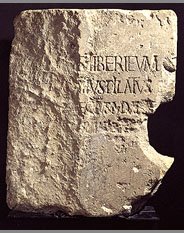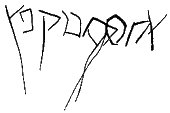The Cradle of Christianity is the title of one of the online exhibitions in the website of The Israel Museum in Jerusalem.
Two of the exhibits caught my eye.
One was an inscription to Pontius Pilate
Two of the exhibits caught my eye.
One was an inscription to Pontius Pilate
 Latin dedicatory inscription of Pontius Pilate
Latin dedicatory inscription of Pontius PilateStone
Roman theatre at Caesarea, 26–36 CE
Israel Antiquities Authority, 61-521
Photo: The Israel Museum, Jerusalem
The inscription reads:
...]S TIBERIVM
...PON]TIVS PILATVS
...PRAEF]ECTVSIVDA[EA
The inscription is the only known artifact bearing Pontius Pilate’s name. It is a dedicatory inscription of a building, probably a temple, constructed in honor of the emperor Tiberius. The inscription was discovered in secondary use in a staircase of the Roman theater at Caesarea, the Roman administrative center for the province of Judea and the seat of the procurators. The procurators visited Jerusalem only on special occasions, or in times of unrest.
The other is the Ossuary of the High Priest Joseph Caiaphas

 Stone
StoneJerusalem, North Talpiot, 1st century CE
Israel Antiquities Authority, 91-468
Photo: The Israel Museum, Jerusalem / by Avraham Hay;
Drawing: The Israel Museum, Jerusalem / by Pnina Arad
"Joseph Caiaphas, high priest from 18 to 36 CE, was a member of the Caiaphas clan and the son-in-law of the high priest Annas. He is chiefly known for his involvement in the arrest of Jesus, described in detail in the New Testament.
The Gospels relate that while Jesus was in Jerusalem for the Passover festival, he was arrested and brought to the house of Joseph Caiaphas, where he spent the night.
The following day, after interrogation, Caiaphas delivered Jesus to the Roman authorities.
The burial cave of the Caiaphas clan was discovered by accident in southeast Jerusalem, near the Sherover Promenade.
It is relatively small, and even though it had been plundered in ancient times, it still contained twelve ossuaries, four of which were decorated. The most elaborate of these is on display here.
The name “Joseph Caiaphas” is inscribed in Hebrew twice upon this ossuary – once along the short side and once vertically, from bottom to top, along the long side. It seems that this inscription was only written after the ossuary has been placed in the burial niche, and the small space between the ossuary and the wall made it necessary to inscribe the name in this unusual manner.
In all probability, inscriptions of this type were simply meant to label the ossuaries, and were therefore rather carelessly done.
If the individual buried in this ossuary was indeed the high priest Joseph Caiaphas, and not another member of his family, this is the first instance in which an ossuary belonging to an historical personage of such consequence has been uncovered in Jerusalem. "

No comments:
Post a Comment